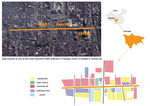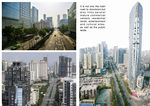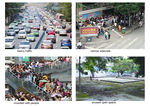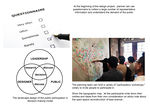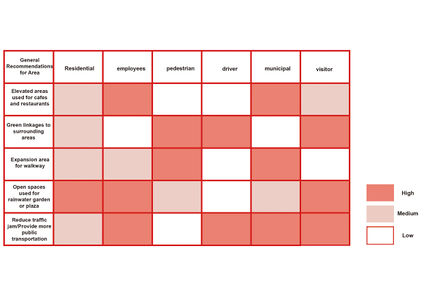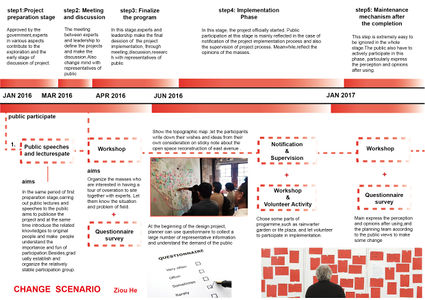Landscape Democracy 2015 Working Group G - Case Study 2
---> back to group page working group G
Please add the title of your case study here, adjust the map coordinates (lat + lng) and replace the moa image with a characteristic image of your site
| Place name | East Avenue | |
| Location | Chengdu | |
| Country | China | |
| Author(s) | Ziou He | |
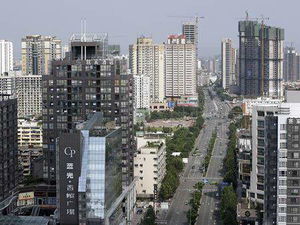
| ||
|
| ||
Rationale: Why have you chosen this case for the landscape and democracy seminar?
East Avenue is one of the most important traffic arteries of Chengdu which is located in central city.It is not only the main road to downtown,but also links several mature commercial centers, residential lands, entertainment and cultural sites, as well as the public lands. But,due to narrow road and heavy traffic, East Avenue is often jammed. In addition, landscape planning on both sides of the street and also in the intersection spaces is unsuitable , which result in that,a large number of users,for instance,residents,office workers,shoppers and also the passers-by can not find a suitable space for their activities .Therefore, aims to use these open space effectively ,the adjustment and reconstruction of this avenue has to create much more spaces which meet the needs of users around. So,"Participatory design" is an important method to understand the demand of the surrounding users.
Representation of your observations
- Observations
Reflection
What are the major challenges for changing the situation?
First of all, "participatory design" involves a wide range of people, they come from different social strata, different degree, different background, and even they have different interests or purpose.Therefore, how to coordinate and organize activities of participation, how to collect and classify the opinions and desires of the masses and then reflect these responses to the planning and design, is a huge challenge.In addition, under the politic background of China, it is difficult to carry out this the political conduct such democratic participation activities. Normally,people have no right and no approach to give their own opinion. Besides, it involves cooperation and coordination of different government departments and design institutions, so how to set up a complete mechanism to maintain such activities, it is a challenge.Moreover, the public participation is not only reflected in the preparation phase and design phase, it is also suitable for the project construction phase, so how to carry out the unique activities let people to join in construction engineering , let residents and users join in the project implementation, is a challenge.
What could be a starting point for democractically-based change?
- Please add approx. 150 words for each questions
At the beginning of the design project, we need to collect all aspects of the planning information, measure social values and determine the direction of the planning and design and target.In this stage, questionnaire is the most common techniques and methods of public participation , through questionnaires can planners collect a large number of representative information and understand the demand of the public, in order to improve the practicability and pertinence of landscape planning and design. In addition, the planning team can hold a variety of "participatory workshops," widely to invite people to participate in.Planners should show the topographic map and let the participants write down their wishes and ideas from their own consideration on sticky note about the open space reconstruction of east avenue .Participants listen to each other, exchange views, and ultimately reach a consensus on each base of planning and design. Another form is the public hearings or discussion meeting.In front of the public landscape planning and design project, hold public hearings or discussion meeting.The professional staff, government officials and the public representatives participate in each aspects,so that the public could understand the background and the goals of the construction project as much as possible .So,hear ideas and queries about the project from the related interest groups, in particular, listen to the opinions of the public representative and then absorb and reflect in the decision process, in order to obtain public understanding and cooperation.
Stakeholder Mapping
Create a visual representation of the stakeholder groups that are involved in your case. Try to cover the following aspects in your representation: Power (high, medium, low) / Support (positive, neutral, negative)/ Influence (high or low)/ Need (strong, medium, weak)+ also map the relationships between the stakeholder groups
- Stakeholder Map
Change Scenario
Look at the various methods and tools available and think how they can be applied creatively. Think about the needs of different stakeholder groups - you may need a methodical mix to address them all. Visualize a scenario illustrating how these methods/tools can be applied within an imagined time frame
- Change Scenario
Cross cutting theme
Identify a cross-cutting theme/topic between the cases of your group and write a short reflection on it (approx. 150 words)
Concluding reflections
Reflect on your case and your change model. Potentials? Limitations? (approx. 150 words)
References
[1] Beam Crane Public (public) participation: experiences and lessons in North America [J] City Planning, 1999,05: 48-52.
[2] Tang Jun, from the functional rationality to public participation ── western modern landscape planning and design of social footprints [J] planners, 2001,04: 101-104.
[3] lnstitutioal Restriction Mechanism of Urban Planning Administration - Public Participation [J] planners, 2002,09: 57-60.
[4] Chen Jinfu On the urban planning system of public participation [J] City Planning, 2000,07: 54-57.
[5] Guomei Feng An Effective Method to Promote Landscape Architecture Design - Public Participation [J] Chinese garden, 2004,01: 81-83.
[6] even Zhen Yu, Liu Bohong, Shi Peiyin, Xie Yi Ling district, community participation in the planning design Green Point - Roosevelt Road, Taipei Green Living axis [J] Chinese garden, 2011,12: 91-93.
[7] Chen Xuan practice of public participation in the modern landscape - Take the Seattle waterfront landscape design example [J] Chinese and foreign construction, 2005,04: 78-81.
About categories: You can add more categories with this tag: "", add your categories
